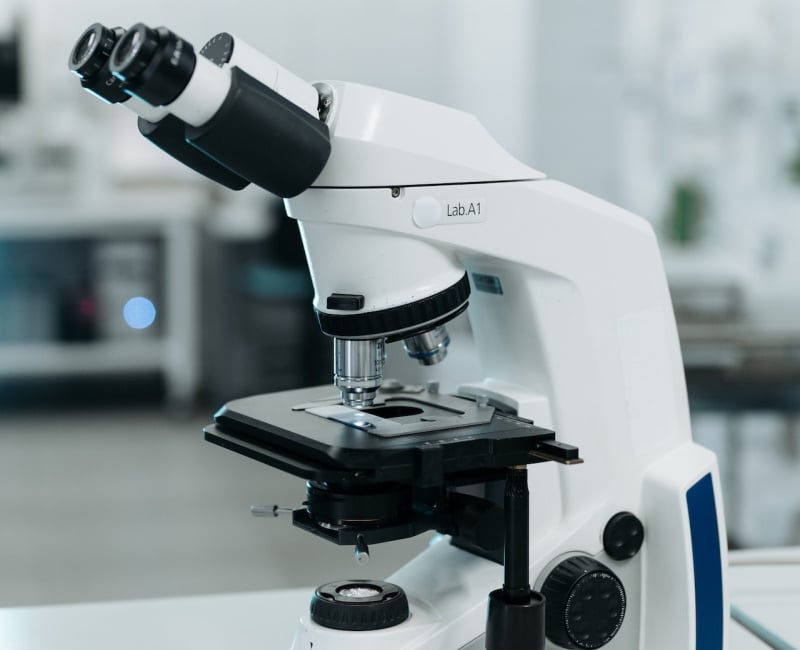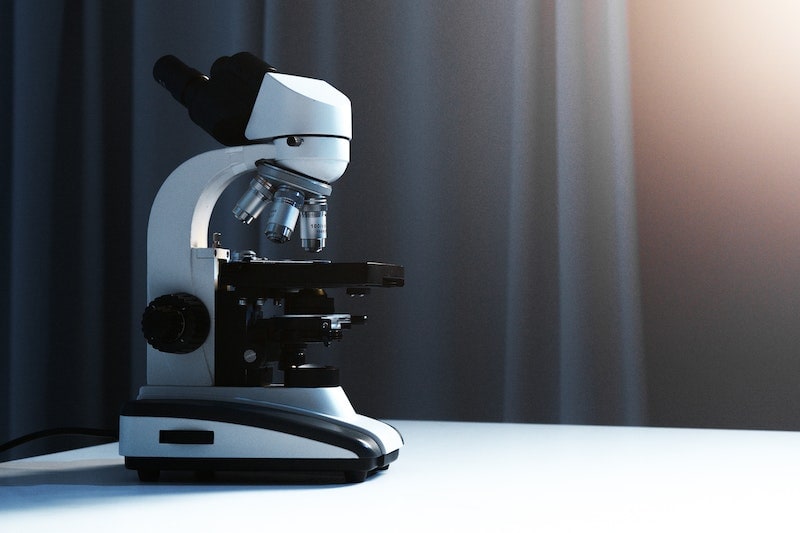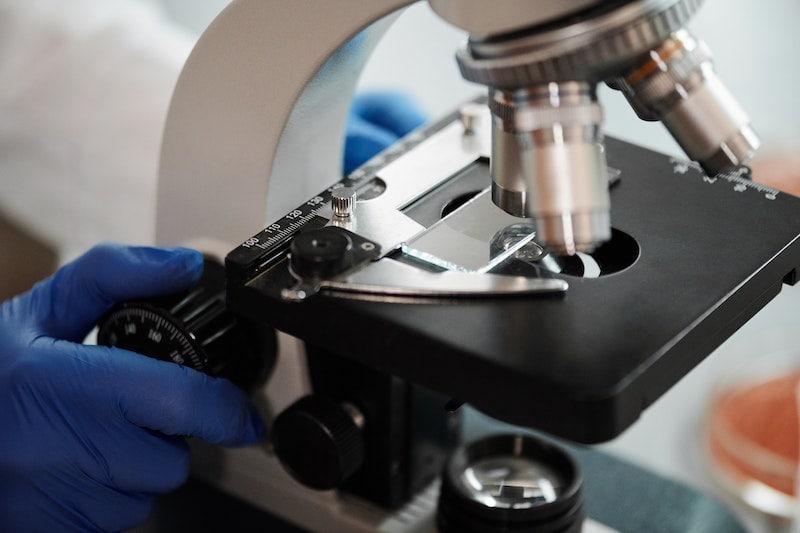What Is a Compound Microscope & What Is It Used For?
Last Updated on

If you’re looking to make small objects look big, you need a microscope. But there are so many microscopes out there to pick from, and when you start looking into all the different types, it can get overwhelming.
One type that you’re bound to come across is the compound microscope. But what exactly is a compound microscope, how does it work, and when do you want to use it? Furthermore, what are the different types of compound microscopes out there? Compound microscopes combine two lenses to reach higher magnification levels.
It’s a great deal of information, so we developed this guide to break down everything that you need to know.

How Does It Work?
A compound microscope uses two different lenses in tandem to magnify an object. The first lens is the objective lens, and it’s closest to the object that you’re trying to magnify. Many compound microscopes enable you to rotate a board with multiple objective lenses to achieve different magnification levels.
The other lens is the ocular lens, also known as the eyepiece. This is the lens that you actually look through, and it takes the magnified object from the first lens and magnifies it again.
Basically, the objective lens magnifies the image once, and then the ocular image magnifies that image again. For instance, with a 20x objective lens, you can see an object at 20x magnification. When you pair it with a 5x ocular lens, you can now see that object at 100x magnification!
What Are the Different Types of Compound Microscopes?

Biological microscopes are compound microscopes that many people used in school as kids, and they’re among the most prevalent types available.
However, they’re not the only ones out there. Another great example is the phase contrast microscope. It enhances the contrast of the object that you’re looking at, without using any dyes that could damage the sample.
Fluorescence microscopes are unique types of compound microscopes. They work great for different biological applications. They use a light that causes the specific objects that they are viewing to light up in a fluorescent way.
Another special microscope type is the metallurgical microscope. It’s common for viewing metals and other opaque objects. In short, these microscopes either shine a light down on or up through an object to try to highlight flaws or other characteristics of opaque objects.
Finally, polarizing microscopes use two different polarizing filters, and these different polarizations highlight different things in the object that you’re looking at.
Where Is It Used?
Due to the many different types of compound microscopes out there, you can find them for use in myriad fields. Jewelers use them to evaluate diamonds and metals in the jewelry that they’re working with. Biologists use them to study microscopic life. Archeologists use them to study ancient artifacts. Teachers use them to educate students about different scientific subjects.
Many scientists use them to discover and observe all sorts of things that we can’t see with our regular vision. In short, compound microscopes are all over the place and are enhancing our understanding of the universe — you just need to know where to look!
Advantages of Compound Microscope

The advantage of a compound microscope is clear: You can reach much higher magnification levels than you could with just one microscope alone. Even better, you only need two smaller lenses instead of one massive and super powerful large lens.
This is the primary advantage of a compound microscope, and it’s popular because your final magnification level is the multiplied total of the magnification levels of the object and ocular lens.
Disadvantages of Compound Microscope
One of the most notable disadvantages of a compound microscope is that it typically only gives you a limited amount of space between the objective lens and the table. This isn’t typically a big deal for small objects, but if you’re trying to look at a small part of a large object, it can become a problem.
Another issue is that while these microscopes are extremely powerful, they typically max out around 1,000x. From there, scientists usually use electron microscopes. Finally, these microscopes also typically have a minimum magnification of 40x.
So, if you want lower magnification levels, a compound microscope likely isn’t what you’re looking for.

Frequently Asked Questions (FAQ)

Compound microscopes are fascinating tools, so you might have questions after learning more about them. We answer a few of these for you here.
Why Is It Called a Compound Microscope?
A compound microscope gets its name from the fact that you’re combining two different lenses in the microscope. Merriam-Webster defines a compound as “something formed by a union of elements or parts.”
With a compound microscope, you’re forming a microscope by combining two different lenses.
What Is the Difference Between a Simple and a Compound Microscope?
While there are multiple types of simple microscopes, it’s still a device that magnifies an object with one lens. A compound microscope consists of two different lenses, which is the difference between a simple microscope and a compound microscope.
How Do You Determine the Magnification of a Compound Microscope?
If you know the magnification levels of the ocular and the objective lens, determining the overall magnification of the compound microscope is easy.
All you need to do is multiply the magnifications of the ocular and the objective lens. For instance, with an objective lens of 50x magnification and an ocular lens of 10x magnification, the total magnification is 500x!
A Quick Reference Guide
| When to Use a Compound Microscope | When to Use Another Type of Microscope |
| When you need high magnification levels | When you need low magnification levels |
| When looking at small objects | When looking at large objects |

Final Thoughts
Compound microscopes are among the most powerful microscopes that the average American will ever use, and it opens up whole new worlds for you to observe.
Now that you know more about them, it’s up to you to decide if you need a compound microscope in your life or if another type of microscope is better for the job.
Featured Image Credit: Magnetic Mcc, Shutterstock
About the Author Robert Sparks
Robert’s obsession with all things optical started early in life, when his optician father would bring home prototypes for Robert to play with. Nowadays, Robert is dedicated to helping others find the right optics for their needs. His hobbies include astronomy, astrophysics, and model building. Originally from Newark, NJ, he resides in Santa Fe, New Mexico, where the nighttime skies are filled with glittering stars.
Related Articles:
Binocular Magnification Chart: Numbers & Distances Compared
What Is the Best Binocular Magnification for Hunting? Optical Features Explained
When Were Binoculars Invented? History, Today & Future
How to Clean a Refractor Telescope: Step-by-Step Guide
How to Clean a Telescope Eyepiece: Step-by-Step Guide
How to Clean a Rifle Scope: 8 Expert Tips
Monocular vs Telescope: Differences Explained (With Pictures)
What Is a Monocular Used For? 8 Common Functions
